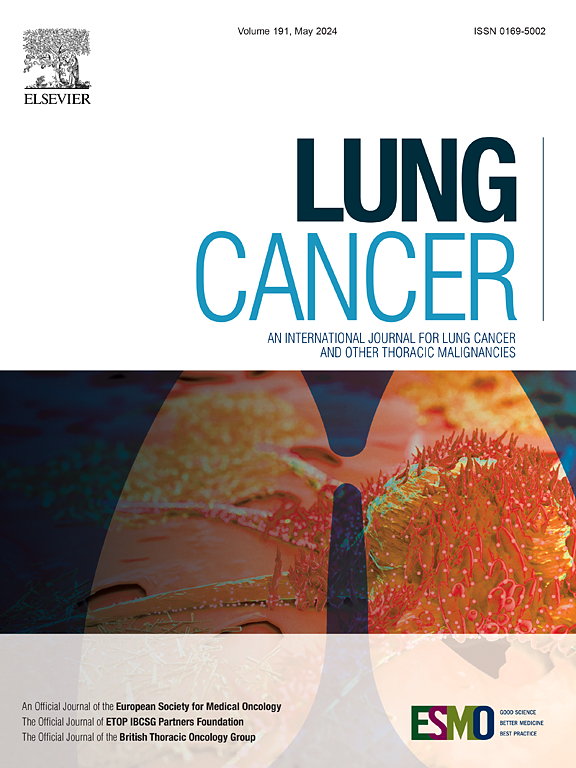血清间皮素作为胸膜间皮瘤反应性生物标志物。
IF 4.4
2区 医学
Q1 ONCOLOGY
引用次数: 0
摘要
背景:CT扫描是目前胸膜间皮瘤(PM)疾病监测的金标准,放射学报告使用修改后的RECIST标准。虽然mRECIST有自己的挑战,但参加CT扫描会增加时间和费用。一种基于血液的生物标志物可以追踪疾病状态,从而实现更灵敏的、基于社区的疾病监测。本研究评估了系列血清间皮素(SM)水平与疾病状态的关系。方法:在2019年2月28日至2023年12月31日期间,从间皮瘤患者的多中心前瞻性队列研究assessment - meso中招募PM患者。采用Logistic回归,调整性别、年龄、组织学、运动状态、eGFR和治疗,评估连续SM与放射学疾病状态的关系。预先指定的亚组分析根据初始SM和治疗状态对参与者进行分层。结果:156例患者在配对CT扫描中进行了≥2次SM测量。无论初始SM情况如何,SM升高与同期(Adj OR 1.11, 95% CI 1.03-1.19)和随后6个月(Adj OR 1.13, 1.03-1.23)的疾病进展相关。SM变化25%为最佳阈值,与疾病进展相关的SM升高25% (Adj OR 2.68(1.52-4.73)),敏感性和特异性分别为48.7%(43.1% - 54.4%)和75.7%(70.8% - 80.5%)。对于接受治疗的患者,SM下降预测随后的疾病反应(Adj OR 1.37, 1.16-1.61)。结论:无论初始值和治疗状态如何,连续SM是PM的可靠反应生物标志物。这些结果支持在常规临床护理中使用SM作为CT扫描的辅助手段,与放射监测相比有几个好处。本文章由计算机程序翻译,如有差异,请以英文原文为准。
Serum mesothelin as a response biomarker in pleural mesothelioma
Background
CT scans are the current gold standard for disease monitoring for Pleural mesothelioma (PM), with radiology reported using the modified RECIST criteria. While mRECIST has its own challenges, attending for CT scans adds time and expense. A blood-based biomarker which tracks disease status could enable more responsive, community-based disease monitoring. This study evaluated the relationship between serial serum mesothelin (SM) levels and disease status.
Methods
Patients with PM were recruited from Assess-Meso, a multi-centre prospective cohort study of patients with mesothelioma, between 28/2/2019 and 31/12/2023. Logistic regression, adjusted for sex, age, histology, performance status, eGFR and treatment, was used to assess the relationship between serial SM and radiological disease status. Prespecified sub-group analyses stratified participants by initial SM and treatment status.
Results
156 patients had ≥ 2 SM measurements with paired CT scans. Rising SM was associated with disease progression in the coincident time period (Adj OR 1.11, 95 % CI 1.03–1.19) and the subsequent 6 months (Adj OR 1.13, 1.03–1.23), regardless of initial SM. A 25 % change in SM was the optimal threshold, with a 25 % rise associated with disease progression (Adj OR 2.68 (1.52–4.73)) with sensitivity and specificity of 48.7 % (43.1 %-54.4 %) and 75.7 % (70.8 %-80.5 %) respectively. For patients receiving treatment, falling SM predicted subsequent disease response (Adj OR 1.37, 1.16–1.61).
Conclusions
Serial SM is a reliable response biomarker in PM, regardless of initial value and treatment status. These results support the use of SM in routine clinical care as an adjunct to CT scans, with several benefits over radiological monitoring.
求助全文
通过发布文献求助,成功后即可免费获取论文全文。
去求助
来源期刊

Lung Cancer
医学-呼吸系统
CiteScore
9.40
自引率
3.80%
发文量
407
审稿时长
25 days
期刊介绍:
Lung Cancer is an international publication covering the clinical, translational and basic science of malignancies of the lung and chest region.Original research articles, early reports, review articles, editorials and correspondence covering the prevention, epidemiology and etiology, basic biology, pathology, clinical assessment, surgery, chemotherapy, radiotherapy, combined treatment modalities, other treatment modalities and outcomes of lung cancer are welcome.
 求助内容:
求助内容: 应助结果提醒方式:
应助结果提醒方式:


